Laser-Patterned Alumina Mask and Mask-Less Dry Etch of Si for Light Trapping with Photonic Crystal Structures
Abstract
:1. Introduction
2. Samples and Methods
3. Results and Discussion
3.1. Laser Ablation of Transparent Mask
3.2. Deep Etching of Si
3.3. Mask-Less Etching of Si
3.4. Energy Deposition and Nonlinear Light–Matter Interaction (above Ablation Threshold)
3.5. Minority Carriers’ Lifetime
4. Conclusions and Outlook
Author Contributions
Funding
Data Availability Statement
Acknowledgments
Conflicts of Interest
Appendix A. Reflection Colour
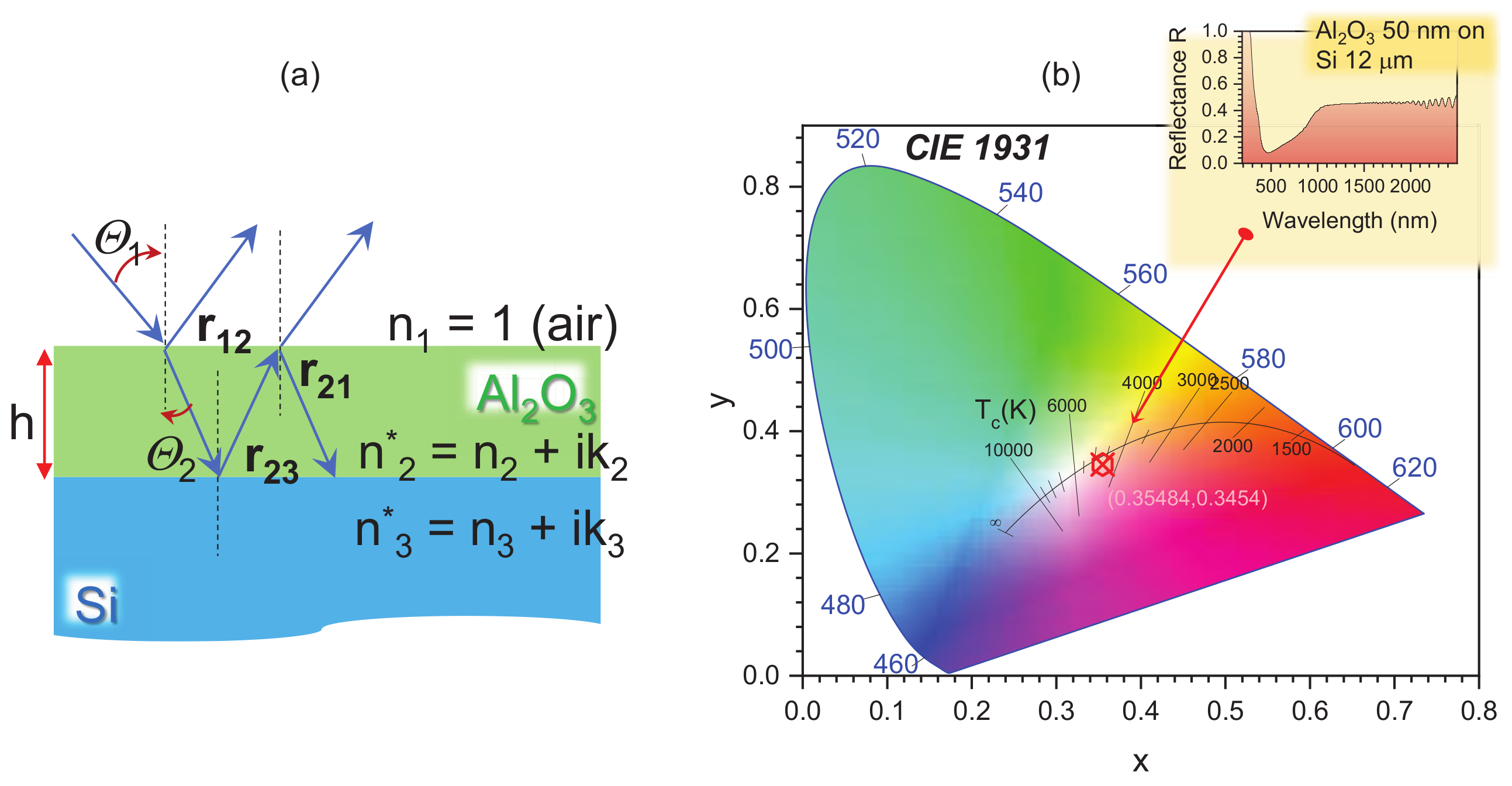
Appendix B. Focal Spot Size: Definitions
References
- Wilson, G.M.; Al-Jassim, M.; Metzger, W.K.; Glunz, S.W.; Verlinden, P.; Xiong, G.; Mansfield, L.M.; Stanbery, B.J.; Zhu, K.; Yan, Y.; et al. The 2020 photovoltaic technologies roadmap. J. Phys. Appl. Phys. 2020, 53, 493001. [Google Scholar] [CrossRef]
- Green, M.A.; Dunlop, E.D.; Hohl-Ebinger, J.; Yoshita, M.; Kopidakis, N.; Hao, X. Solar cell efficiency tables (version 59). Prog. Photovol. Res. Appl. 2022, 30, 3–12. [Google Scholar] [CrossRef]
- Jager-Waldau, A. Progress in chalcopyrite compound semiconductor research for photovoltaic applications and transfer of results into actual solar cell production. Sol. Energy Mater. Sol. Cells 2011, 95, 1509–1517. [Google Scholar] [CrossRef]
- Wolden, C.; Kurtin, J.; Baxter, J.; Repins, I.; Shaheen, S.; Torvik, J.; Rockett, A.; Fthenakis, V.; Aydil, E. Photovoltaic manufacturing: Present status, future prospects, and research needs. J. Vac. Sci. Technol. A 2011, 29, 030801. [Google Scholar] [CrossRef] [Green Version]
- Arnulf, J.W. Photovoltaic Status Report 2019; Publications Office of the EU: Brussels, Belgium, 2019; Volume 1. [Google Scholar]
- Boriskina, S.V.; Green, M.A.; Catchpole, K.; Yablonovitch, E.; Beard, M.C.; Okada, Y.; Lany, S.; Gershon, T.; Zakutayev, A.; Tahersima, M.H.; et al. Roadmap on optical energy conversion. J. Optics 2016, 18, 073004. [Google Scholar] [CrossRef] [Green Version]
- Ludin, N.A.; Mustafa, N.I.; Hanafiah, M.M.; Ibrahim, M.A.; Asri Mat Teridi, M.; Sepeai, S.; Zaharim, A.; Sopian, K. Prospects of life cycle assessment of renewable energy from solar photovoltaic technologies: A review. Renew. Sustain. Energy Rev. 2018, 96, 11–28. [Google Scholar] [CrossRef]
- Maksimovic, J.; Hu, J.; Ng, S.H.; Katkus, T.; Seniutinas, G.; Pinedo Rivera, T.; Stuiber, M.; Nishijima, Y.; John, S.; Juodkazis, S. Beyond Lambertian light trapping for large-area silicon solar cells: Fabrication methods. Opto-Electron. Adv. 2022, 5, 210086. [Google Scholar] [CrossRef]
- Bhattacharya, S.; Baydoun, I.; Lin, M.; John, S. Towards 30% Power Conversion Efficiency in Thin-Silicon Photonic-Crystal Solar Cells. Phys. Rev. Appl. 2019, 11, 014005. [Google Scholar] [CrossRef] [Green Version]
- Eyderman, S.; John, S. Trapping and Recycling for Extraordinary Power Conversoin in Ultra-thin Gallium-Arsenide Solar Cells. Sci. Rep. 2016, 6, 28303. [Google Scholar] [CrossRef] [Green Version]
- Eyderman, S.; John, S.; Deinega, A. Solar light trapping in slanted conical-pore photonic crystals: Beyond statistical ray trapping. J. Appl. Phys. 2013, 113, 154315. [Google Scholar] [CrossRef] [Green Version]
- Deinega, A.; Eyderman, S.; John, S. Coupled optical and electrical modelling of solar cell based on conical pore silicon photonic crystals. J. Appl. Phys. 2013, 113, 224501. [Google Scholar] [CrossRef]
- Chutinan, A.; John, S. Light trapping and absorption optimization in certain thin-film photonic crystal architectures. Phys. Rev. A 2008, 78, 023825. [Google Scholar] [CrossRef] [Green Version]
- Mavrokefalos, A.; Han, S.E.; Yerci, S.; Branham, M.S.; Chen, G. Efficient Light Trapping in Inverted Nanopyramid Thin Crystalline Silicon Membranes for Solar Cell Applications. Nano Lett. 2012, 12, 2792–2796. [Google Scholar] [CrossRef]
- Foster, S.; John, S. Light-trapping design for thin-film silicon-perovskite tandem solar cells. J. Appl. Phys. 2016, 120, 103103. [Google Scholar] [CrossRef] [Green Version]
- Kuang, P.; Eyderman, S.; Hsieh, M.L.; Post, A.; John, S.; Lin, S.Y. Achieving an Accurate Surface Profile of a Photonic Crystal for Near-Unity Solar Absorption in a Super Thin-Film Architecture. ACS Nano 2016, 10, 6116–6124. [Google Scholar] [CrossRef]
- Shockley, W.; Queisser, H.J. Detailed Balance Limit of Efficiency of p-n Junction Solar Cells. J. Appl. Phys. 1961, 32, 510–519. [Google Scholar] [CrossRef]
- Kaneka Achieves New Efficiency Record for a Practical Size Crystalline Silicon PV Cell. PV Magazine. 2016. Available online: https://www.pv-magazine.com (accessed on 19 September 2016).
- Haase, F.; Hollemann, C.; Schäfer, S.; Merkle, A.; Rienäcker, M.; Krügener, J.; Brendel, R.; Peibst, R. Laser contact openings for local poly-Si-metal contacts enabling 26.1%-efficient POLO-IBC solar cells. Sol. Energy Mater. Sol. Cells 2018, 186, 184–193. [Google Scholar] [CrossRef]
- Hollemann, C.; Haase, F.; Schäfer, S.; Krügener, J.; Brendel, R.; Peibst, R. 26.1%-efficient POLO-IBC cells: Quantification of electrical and optical loss mechanisms. Prog. Photovol. 2019, 27, 950–958. [Google Scholar] [CrossRef]
- Han, M.; Smith, D.; Ng, S.H.; Vilagosh, Z.; Anand, V.; Katkus, T.; Reklaitis, I.; Mu, H.; Ryu, M.; Morikawa, J.; et al. THz Filters Made by Laser Ablation of Stainless Steel and Kapton Film. Micromachines 2022, 13, 1170. [Google Scholar] [CrossRef]
- Juodkazis, S.; Nishi, Y.; Misawa, H.; Mizeikis, V.; Schecker, O.; Waitz, R.; Leiderer, P.; Scheer, E. Optical transmission and laser structuring of silicon membranes. Opt. Express 2009, 17, 15308–15317. [Google Scholar] [CrossRef]
- Liu, X.Q.; Yu, L.; Yang, S.N.; Chen, Q.D.; Wang, L.; Juodkazis, S.; Sun, H.B. Optical Nanofabrication of Concave Microlens Arrays. Laser Photonics Rev. 2019, 13, 1800272. [Google Scholar] [CrossRef]
- Bonse, J.; Baudach, S.; Krüger, J.; Kautek, W.; Lenzner, M. Femtosecond laser ablation of silicon–modification thresholds and morphology. Appl. Phys. A 2002, 74, 19–25. [Google Scholar] [CrossRef]
- Miwa, M.; Juodkazis, S.; Kawakami, T.; Matsuo, S.; Misawa, H. Femtosecond Two-photon Stereo-lithography. Appl. Phys. A 2001, 73, 561–566. [Google Scholar] [CrossRef]
- Markvart, T.; Castañer, L. Chapter I-1-A-Principles of Solar Cell Operation. In McEvoy’s Handbook of Photovoltaics, 3rd ed.; Kalogirou, S.A., Ed.; Academic Press: Cambridge, MA, USA, 2018; pp. 3–28. [Google Scholar] [CrossRef]
- Thomas, R. 24-Silicon Solar Cells (1)—Basics. In Solar Energy Conversion; Dixon, A., Leslie, J., Eds.; Pergamon: Oxford, UK, 1979; pp. 785–803. [Google Scholar] [CrossRef]
- Thick Slabs and Thin Films. In The Physics of Thin Film Optical Spectra: An Introduction; Springer: Berlin/Heidelberg, Germany, 2005; pp. 101–124. [CrossRef]
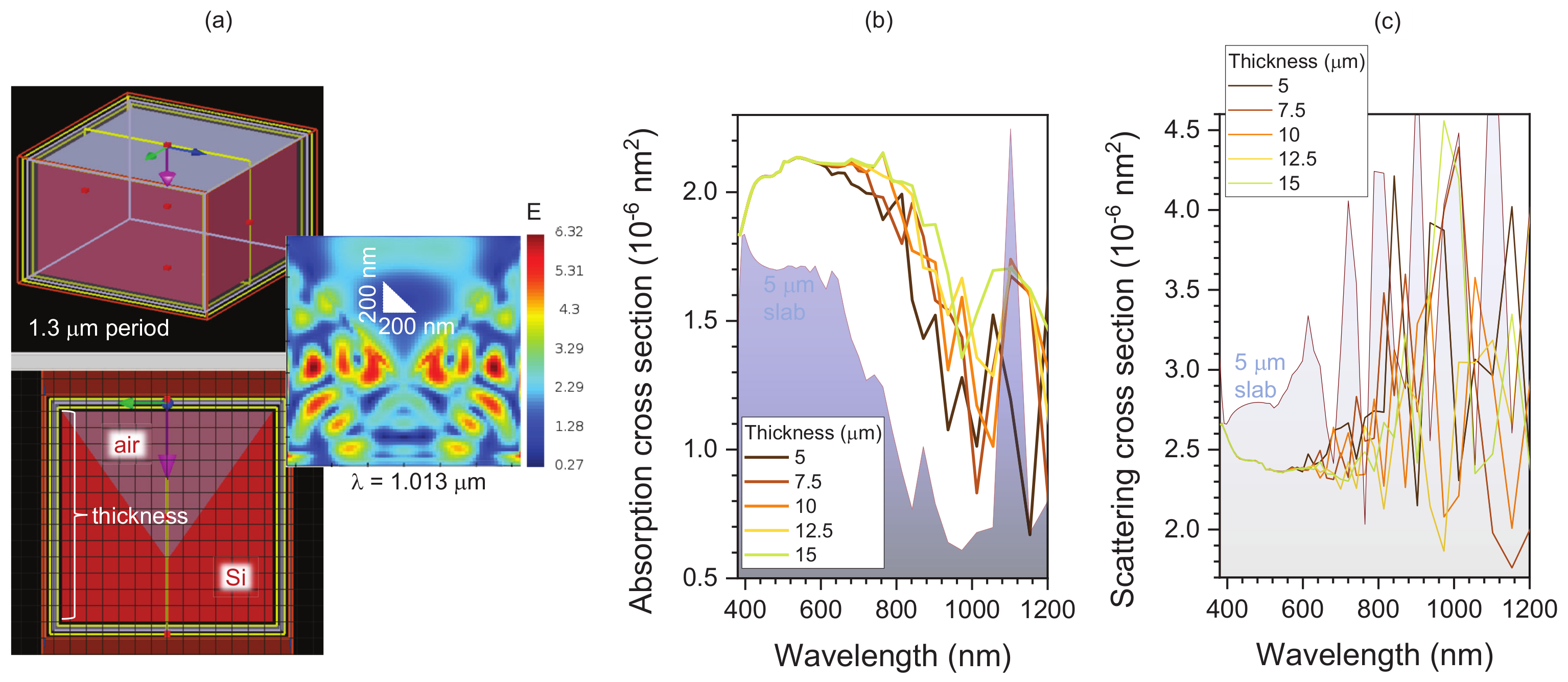

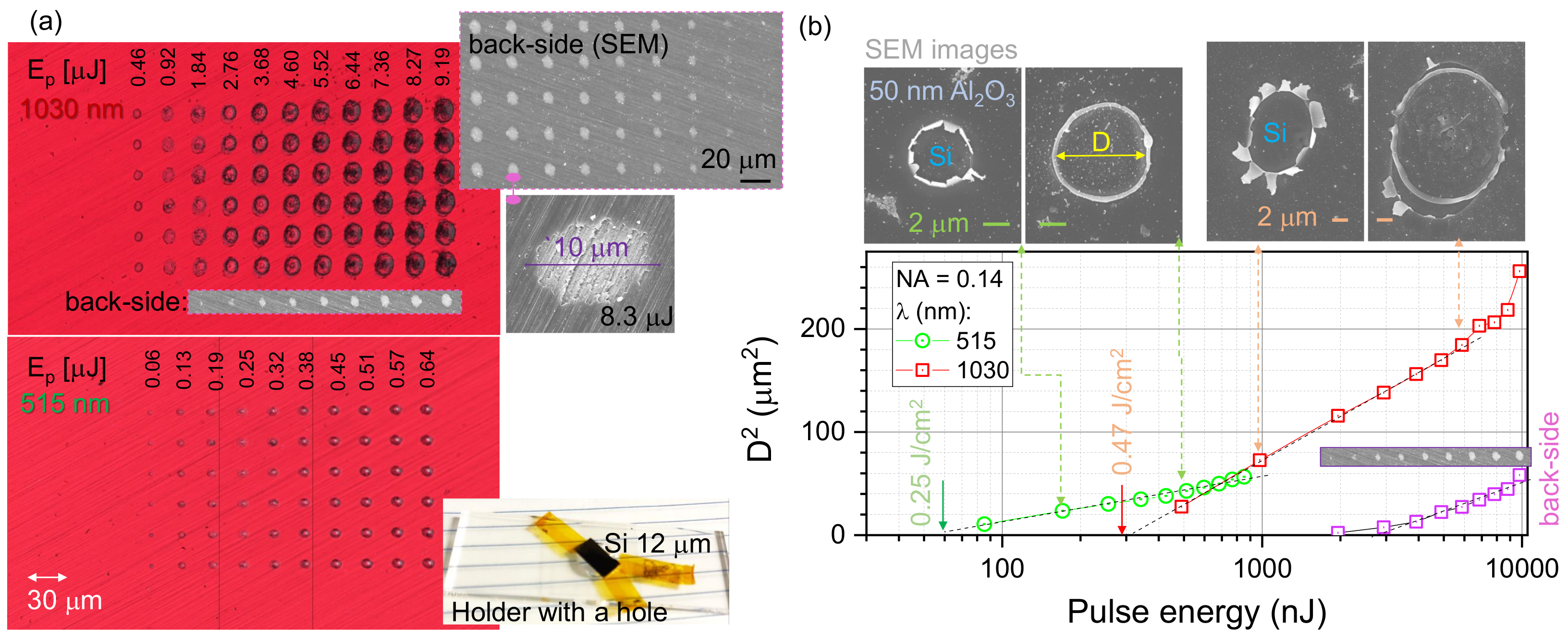


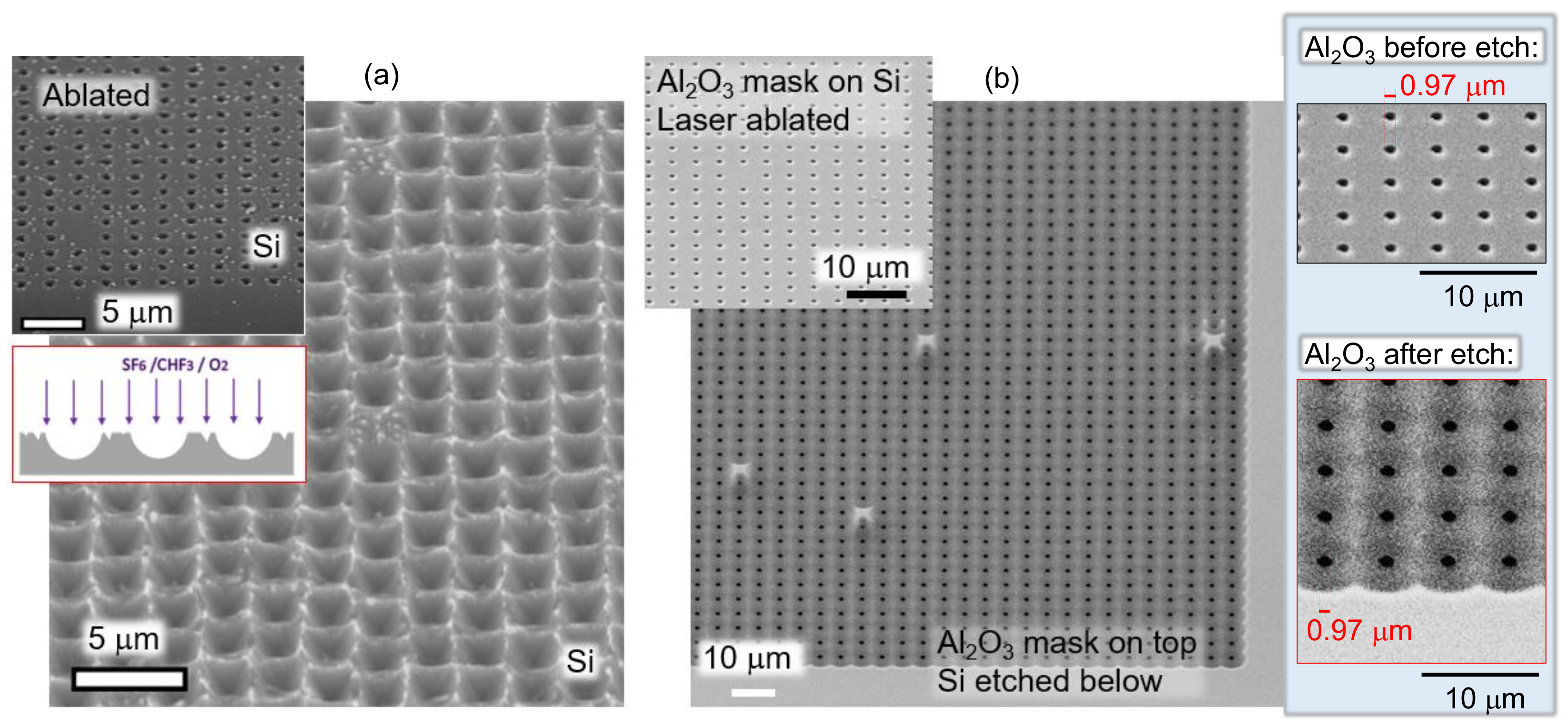
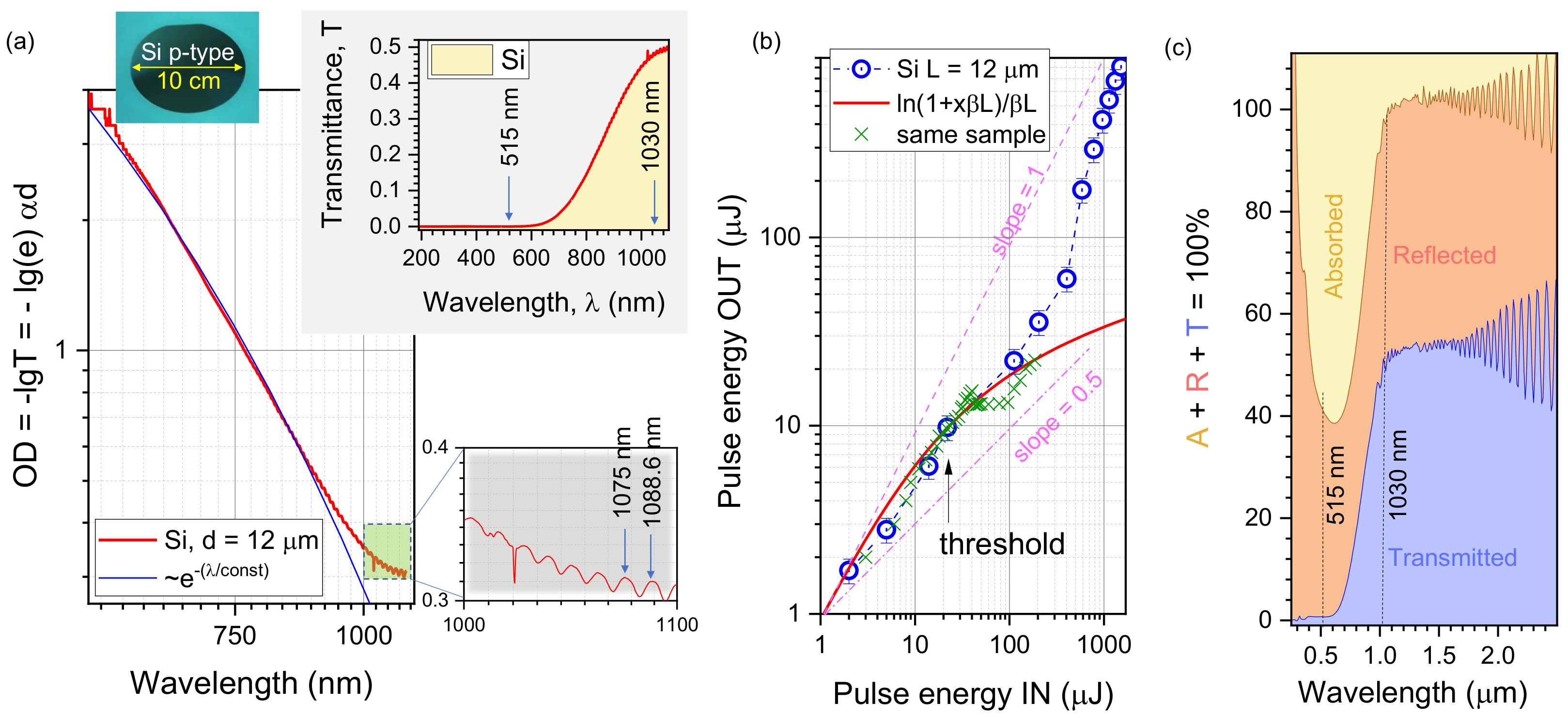
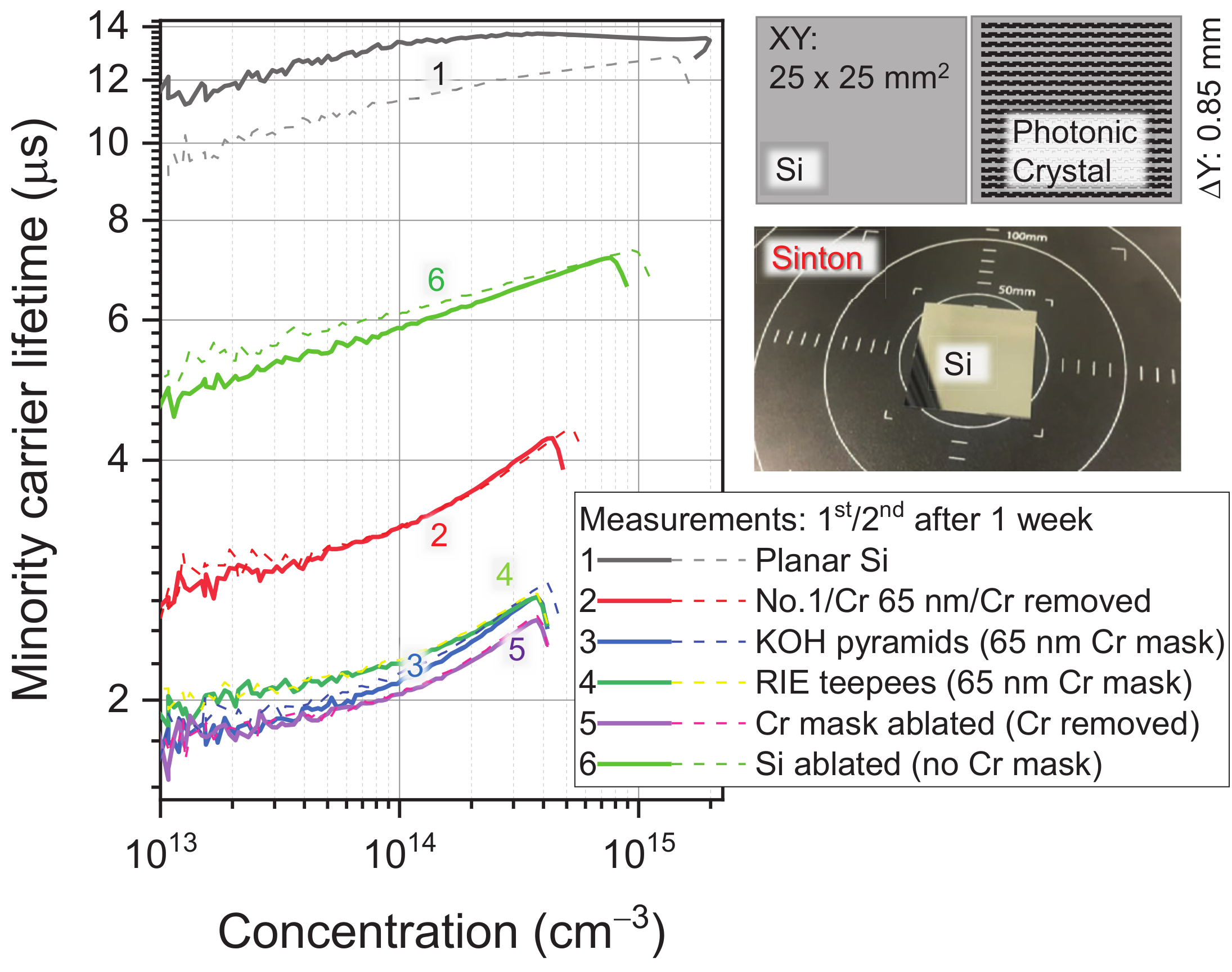
Disclaimer/Publisher’s Note: The statements, opinions and data contained in all publications are solely those of the individual author(s) and contributor(s) and not of MDPI and/or the editor(s). MDPI and/or the editor(s) disclaim responsibility for any injury to people or property resulting from any ideas, methods, instructions or products referred to in the content. |
© 2023 by the authors. Licensee MDPI, Basel, Switzerland. This article is an open access article distributed under the terms and conditions of the Creative Commons Attribution (CC BY) license (https://creativecommons.org/licenses/by/4.0/).
Share and Cite
Maksimovic, J.; Mu, H.; Smith, D.; Katkus, T.; Vaičiulis, M.; Aleksiejūnas, R.; Seniutinas, G.; Ng, S.H.; Juodkazis, S. Laser-Patterned Alumina Mask and Mask-Less Dry Etch of Si for Light Trapping with Photonic Crystal Structures. Micromachines 2023, 14, 550. https://doi.org/10.3390/mi14030550
Maksimovic J, Mu H, Smith D, Katkus T, Vaičiulis M, Aleksiejūnas R, Seniutinas G, Ng SH, Juodkazis S. Laser-Patterned Alumina Mask and Mask-Less Dry Etch of Si for Light Trapping with Photonic Crystal Structures. Micromachines. 2023; 14(3):550. https://doi.org/10.3390/mi14030550
Chicago/Turabian StyleMaksimovic, Jovan, Haoran Mu, Daniel Smith, Tomas Katkus, Mantas Vaičiulis, Ramūnas Aleksiejūnas, Gediminas Seniutinas, Soon Hock Ng, and Saulius Juodkazis. 2023. "Laser-Patterned Alumina Mask and Mask-Less Dry Etch of Si for Light Trapping with Photonic Crystal Structures" Micromachines 14, no. 3: 550. https://doi.org/10.3390/mi14030550




